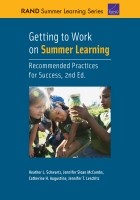| 来源类型 | Research Reports
|
| 规范类型 | 报告
|
| DOI | https://doi.org/10.7249/RR366-1
|
| ISBN | 9781977401786
|
| 来源ID | RR-366-1-WF
|
| Getting to Work on Summer Learning: Recommended Practices for Success, 2nd Ed. |
| Heather L. Schwartz; Jennifer Sloan McCombs; Catherine H. Augustine; Jennifer T. Leschitz
|
| 发表日期 | 2018
|
| 出版年 | 2018
|
| 页码 | 90
|
| 语种 | 英语
|
| 结论 |
Summer learning programs do have a positive effect- Students who received a minimum of 25 hours of mathematics instruction in a summer performed better on the subsequent state math test; those receiving 34 hours of language arts performed better on the subsequent state English language arts assessment.
- Participants also displayed stronger social and emotional competencies.
- However, several components are needed for successful summer programs.
Plan early and well- Commit in the fall to a summer program, and start active planning by January with a program director who has at least half of his or her time devoted to the job.
- Plan for both enrichment activities and academics.
Recruit and hire the district's most highly effective teachers and train them- Select teachers for content knowledge and experience teaching the relevant grade levels of students.
- Prior to the start of the summer program, professional development for summer teachers should include specific guidance on use of the summer curricula, minimizing loss of instructional minutes, and on checking for student understanding. It also should stress the point that academics contribute to, rather than detract from, summer fun.
Schedule the program to include at least 25 hours of math and 34 hours of language arts- Operate the program for five to six weeks with three to four hours of academics per day.
- Provide time for transitions in the master schedule to avoid loss of instructional minutes.
- Provide teachers with concrete strategies for maximizing instructional time.
Adopt student recruitment and attendance policies that aim for high attendance rates- Develop timely recruitment materials that accurately describe the summer program.
- Establish a firm enrollment deadline and clear attendance policy.
- Track rates of students who sign up but do not attend; also track daily attendance once the program starts.
Teachers should have high-quality curriculum materials and small class sizes- Engage experts to anchor the program in written curricula that align with school-year standards and student needs.
- Encourage leaders to observe instruction of the curriculum and provide feedback.
- Select a model for providing enrichment activities.
- Ensure that enrichment instructors have strong content knowledge and train them in behavior management strategies.
Adopt intentional policies related to site climate, which drives student enjoyment and is correlated with attendance- Train all staff on the importance of positive adult engagement with students throughout the day — not only in classes.
- Develop a clear, positive message about the summer site culture and ask staff to convey it consistently to students.
- Ensure that site leaders observe instructional and noninstructional periods.
To sustain summer programs over time, consider cost-saving measures- Hire staff to achieve desired ratios based on projected daily attendance, not the initial number of enrollees.
- Consider cost-efficiencies in the design of the program, but weigh them against potential impacts on program quality.
|
| 主题 | Academic Achievement
; After-School Programs
; Disadvantaged Students
; Educational Administration
; Educational Program Evaluation
; Summer Learning
|
| URL | https://www.rand.org/pubs/research_reports/RR366-1.html
|
| 来源智库 | RAND Corporation (United States)
|
| 引用统计 |
|
| 资源类型 | 智库出版物
|
| 条目标识符 | http://119.78.100.153/handle/2XGU8XDN/108892
|
推荐引用方式
GB/T 7714 |
Heather L. Schwartz,Jennifer Sloan McCombs,Catherine H. Augustine,et al. Getting to Work on Summer Learning: Recommended Practices for Success, 2nd Ed.. 2018.
|
|
文件名:
|
x1541073227993.jpg
|
|
格式:
|
JPEG
|

|
文件名:
|
RAND_RR366-1.pdf
|
|
格式:
|
Adobe PDF
|
除非特别说明,本系统中所有内容都受版权保护,并保留所有权利。